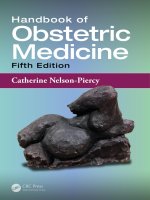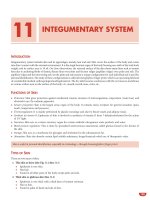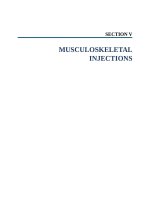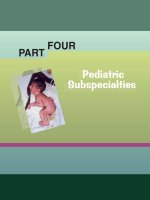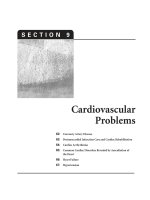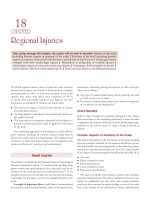Ebook Textbook of oral medicine (2/E): Part 1
Bạn đang xem bản rút gọn của tài liệu. Xem và tải ngay bản đầy đủ của tài liệu tại đây (16.64 MB, 531 trang )
Textbook of
ORAL MEDICINE
DISCLAIMER NOTICE
The information in this book should not be used by unqualified personnel to do
any self diagnosis. All dental surgeons are requested to kindly verify the latest
prescribing practices prior to making decision. Most values are indicative and
have been checked against latest reliable sources, but the publisher and
author do not have any direct or indirect liability to the use or misuse of this
information.
Prior to prescribing any medication please check that they are from ethical
drug manufactures following sound quality control practice. Follow the
manufacture direction in most prescription and please confirm side effect, safety
in children and pregnancy.
Author
Textbook of
ORAL MEDICINE
Second Edition
Anil Govindrao Ghom
MDS (Oral Medicine and Radiology)
Professor and Head
Department of Oral Medicine and Radiology
Chhattisgarh Dental College and Research Institute
Rajnandgaon, Chhattisgarh, India
Formerly
Rural Dental College, Loni
VSPM Dental College, Nagpur
®
JAYPEE BROTHERS MEDICAL PUBLISHERS (P) LTD
St Louis (USA) • Panama City (Panama) • New Delhi • Ahmedabad • Bengaluru
Chennai • Hyderabad • Kochi • Kolkata • Lucknow • Mumbai • Nagpur
Published by
Jitendar P Vij
Jaypee Brothers Medical Publishers (P) Ltd
Corporate Office
4838/24 Ansari Road, Daryaganj, New Delhi 110 002, India, Phone: +91-11-43574357, Fax: +91-11-43574314
Registered Office
B-3 EMCA House, 23/23B Ansari Road, Daryaganj, New Delhi 110 002, India
Phones: +91-11-23272143, +91-11-23272703, +91-11-23282021,
+91-11-23245672, Rel: +91-11-32558559 Fax: +91-11-23276490, +91-11-23245683
e-mail: , Website: www.jaypeebrothers.com
Branches
2/B, Akruti Society, Jodhpur Gam Road Satellite
Ahmedabad 380 015 Phones: +91-79-26926233, Rel: +91-79-32988717
Fax: +91-79-26927094 e-mail:
202 Batavia Chambers, 8 Kumara Krupa Road, Kumara Park East
Bengaluru 560 001 Phones: +91-80-22285971, +91-80-22382956
+91-80-22372664, Rel: +91-80-32714073
Fax: +91-80-22281761 e-mail:
282 IIIrd Floor, Khaleel Shirazi Estate, Fountain Plaza, Pantheon Road
Chennai 600 008 Phones: +91-44-28193265, +91-44-28194897
Rel: +91-44-32972089 Fax: +91-44-28193231 e-mail:
4-2-1067/1-3, 1st Floor, Balaji Building, Ramkote Cross Road
Hyderabad 500 095 Phones: +91-40-66610020, +91-40-24758498, Rel:+91-40-32940929
Fax:+91-40-24758499, e-mail:
No. 41/3098, B & B1, Kuruvi Building, St. Vincent Road
Kochi 682 018, Kerala Phones: +91-484-4036109, +91-484-2395739
+91-484-2395740 e-mail:
1-A Indian Mirror Street, Wellington Square
Kolkata 700 013 Phones: +91-33-22651926, +91-33-22276404, +91-33-22276415
Fax: +91-33-22656075, e-mail:
Lekhraj Market III, B-2, Sector-4, Faizabad Road, Indira Nagar
Lucknow 226 016 Phones: +91-522-3040553, +91-522-3040554
e-mail:
106 Amit Industrial Estate, 61 Dr SS Rao Road, Near MGM Hospital, Parel
Mumbai 400012 Phones: +91-22-24124863, +91-22-24104532,
Rel: +91-22-32926896 Fax: +91-22-24160828, e-mail:
“KAMALPUSHPA” 38, Reshimbag, Opp. Mohota Science College, Umred Road
Nagpur 440 009 (MS) Phone: Rel: +91-712-3245220
Fax: +91-712-2704275 e-mail:
North America Office
1745, Pheasant Run Drive, Maryland Heights (Missouri), MO 63043, USA, Ph: 001-636-6279734
e-mail: ,
Central America Office
Jaypee-Highlights Medical Publishers Inc. City of Knowledge, Bld. 237, Clayton, Panama City, Panama Ph: 507-317-0160
Textbook of Oral Medicine
© 2010, Anil Govindrao Ghom
All rights reserved. No part of this publication should be reproduced, stored in a retrieval system, or transmitted in any form or by any
means: electronic, mechanical, photocopying, recording, or otherwise, without the prior written permission of the author and the publisher.
This book has been published in good faith that the material provided by author is original. Every effort is made to ensure
accuracy of material, but the publisher, printer and author will not be held responsible for any inadvertent error(s). In case of any
dispute, all legal matters to be settled under Delhi jurisdiction only.
First Edition: 2005
Reprint: 2006, 2007
Second Edition: 2010
ISBN 978-81-8448-700-8
Typeset at JPBMP typesetting unit
Printed at Nutech
To
My Mother,
My Daughter Milini,
My Son Sanvil,
My Wife Savita
and
My Family
Contributors
Vikas Meshram
Reader,
Chhattisgarh
Dental College and
Research Institute,
Rajnandgaon,
Chhattisgarh
Ch 48: Emergency
Drugs used in
Dentistry
Sachin Manglekar
Reader, School of
Dental Science,
Krishna Institute of
Medical Science
University, Karad,
Maharashtra
Ch 46: Desensitizing
Agents, Gum Paints
and Mouthwashes
Savita Ghom
Lecturer,
Chhattisgarh
Dental College and
Research Institute,
Rajnandgaon,
Chhattisgarh
Ch 43: Anticancer
Drugs
Ch 47: Drugs used in
Pregnancy
Raghvendra Shetty
Reader,
Chhattisgarh
Dental College and
Research Institute,
Rajnandgaon,
Chhattisgarh
Ch 40: Antibiotics
Amit Parate
Lecturer,
Government Dental
College and
Hospital, Nagpur,
Maharashtra
Ch 20: Oral
Pigmentation
Vaishali Gawande
Lecturer,
Chhattisgarh
Dental College and
Research Institute,
Rajnandgaon,
Chhattisgarh
Ch 42: Antifungal
Drugs
Ch 44: Antiviral
Drugs
Abhishek Soni
Reader, VSPM
Dental College and
Research Institute,
Nagpur,
Maharashtra
Ch 24: Gingival and
Periodontal Diseases
Anjusha Ganar
Ex-lecturer,
Chhattisgarh
Dental College and
Research Institute,
Rajnandgaon,
Chhattisgarh
Ch 45: Corticosteroids
Neeta Wasnik
Lecturer,
Chhattisgarh
Dental College and
Research Institute,
Rajnandgaon,
Chhattisgarh
Ch 41: Analgesic and
Anti-inflammatory
Drugs
Foreword
“Enthusiasm is a driving force that overcomes all obstacles”
It is my proud privilege to write a foreword for second edition of this book by Dr Anil Ghom. In
short time, this book has become most popular among undergraduates and postgraduates all over
the country.
In the second edition, numbers of chapters have been presented in a better organized manner.
This book carries updated information of the subject in this rapidly changing world of science. A
new chapter “Controversial Diseases and Terminologies” is incorporated, also there are large
number of new photographs, radiographs, MCQs and references. I am sure this new updated
second edition will be more beneficial for the undergraduate and postgraduate students for reference
and regular reading.
RN Mody
Professor and Head
Department of Oral Medicine and Radiology
Hitkarini Dental College
Jabalpur, MP
Preface to the Second Edition
‘We become strong only after we have acknowledged our weakness. Gather knowledge,
insight, and experience and then make your own decision’
This is the second edition of the textbook and I am gratified by the acceptance and support that
the book has received over the years from educators, students and practitioners. The purpose of
second edition of this book is two-fold. First, to include what is new and recent knowledge and
the second is correct shortcoming of the first edition. I have evaluated and utilized suggestions
from all the critical reviews and recommendations from the faculty members.
Obviously, each successive edition of textbook finds the edition with more information. So in
this edition I have attempted to solidify and include recent knowledge. This book also includes a new Chapter Controversial
Diseases and Terminologies. Purpose of this chapter is that as knowledge is changing everyday with advanced diagnostic
techniques, many old terminologies are discarded and new one are introduced.
My first book was criticized a lot for not including references and not having enough photographs in the book. So in
this second edition I have included references and around 1000 photographs/illustrations for easy understanding of the
diseases.
MCQs chapter is completely revised and all the new MCQs are added at the end of chapter. I have also included
diagnosis of each lesion in diseases, so that students can understand key point in disease and they can easily remember
it.
Again, as a human being, mistakes are bound to happen. I tried this second edition to best of my efforts, still there can
be shortcoming and I request readers to make note of it and I will try to rectify it in the next edition.
Anil Govindrao Ghom
Preface to the First Edition
“You must not be discouraged if the world does not rush to you, demanding what you have; neither must
you quietly sit down to let world wonder and then seek you; you must be aggressive, you must carry your
truths to people and cause them to see them so clearly that they must accept them”
The student looked for a reference on which to build an educational foundation with
regard to basic principle. A few years ago much of the information offered in this text was not
available.
Since the principle and treatment modalities offered herein will continue to evolve, it behooves
the student to be fully informed of the state-of-art to be able to critically evaluate the worthiness or
applicability of any future development.
I have endeavored to ensure that a consistent style has emerged and is in harmony where appropriate with the diseases
of oral region along with the differential diagnoses which are covered in detail.
The purpose of this book is to correlate the gross and microscopic pathological features with the radiographic appearance
of oral diseases and systemic diseases manifested in the jaw.
In our increasingly litigious society, it is vital that the dentist understands the law as it relates to dentistry. The Chapter
on Medicolegal Issue is Essential Reading, along with the Consumer Protection Act.
Diseases can be understood best when the interpreter understands not only the disease process but also the basic
science associated with it. For this reason, I have included separate section for basic science.
Recently, as exam pattern is changing and MCQs are getting importance, MCQs are added in separate chapter.
I tried my best, to cover all the aspects of oral diseases in my book. If this goal is achieved, then this textbook may
contribute, in a small way to better care of patients who suffer from these diseases.
Anil Govindrao Ghom
Acknowledgements
‘The man who really wants to do something finds a way, the other finds an excuse’
No work will be complete without help of your friends and well wishers and I am lucky to have them with me in this
venture.
First of all, I am immensely thankful to Dr Vaishali Gawande for her untiredly help in completion of this project. My
special thanks to Dr Neeta Wasnik and Dr Anjusha Ganar who helped me a lot.
I am also thankful to Dr Swapnil Diwakirti for her help in preparation of diagrams in the book. I am thankful to all the
contributors for their contribution in this book.
My sincere thanks to Dr Pravin Lambade, Dr Jitendra Sachdeo, Dr Vikas Meshram, Dr Bhaskar Patle, Dr Revant Chole,
Dr Amit Parate, Dr Sanjay Pincha, Dr Milind Chandurkar, Dr Ashok L, Dr Umaraji, Dr Tapasya Karemore, Dr Avinash
Kshar, Dr M Shimizu, Dr Fusun Yasar, Dr Iswar, Dr Bande, Dr Kadam, Dr R Kamikawa, Dr FM Debta and Dr Suwas
Darvekar for providing clinical and radiological photographs in the book.
Beauty is God’s gift but to utilize it in proper direction is in your hand. I am thankful to all those beautiful faces in
book— Dr Gagandeep Chawala, Dr Smiriti Goswami, Dr Uma Rohra, Dr Swapnil Dewakirti, and Dr Pragya Jaiswal.
I would like to thank Dr Ranit Chhabra, Dr Priyanka Aggarwal, Dr Shaheen Hamdani, Dr Payal Tapadiya, and
Dr Vivek Lath for their help in proofreading.
I offer my humble gratitude to my guide Dr RN Mody for his guidance during my postgraduation and after postgraduation.
Friends are always big supporters so I am grateful to Dr Pravin Sundarkar, Dr Neeraj Alladwar and Dr Ravindra
Govindwar for heartily wishes. I am also thankful to my brothers and sisters especially elder brother Sadanand for their
moral support in my life.
I am thankful to Shri Jitendar P Vij (Chairman and Managing Director) and Mr Tarun Duneja (Director-Publishing) of
M/s Jaypee Brothers Medical Publishers (P) Ltd., for publishing this book. Commendable type setting, proofreading and
improvement in illustrations have been done respectively by Ms Sunita Katla, Md Shakiluzzaman & Ms Geeta Srivastava
and Mr Sumit Kumar.
Whenever I think who completely changes my life is my wife Savita, who is there in my thick and thin. Whenever I am
down, she is there to uplift me with her prayer and support. She is a person with generous heart and I am thankful to God
to give gift like her to me in my life.
Lastly, I offer my earnest prayers to the Almighty for endowing me the strength and confidence in accomplishing to the
best of my abilities.
Contents
Section 1
Basics
1. Oral Diseases: An Introduction .....................................................................................................................3
2. Development and Eruption of Teeth ............................................................................................................5
3. Development and Anatomy of Craniofacial Region ................................................................................9
4. Immunity, Antigen-Antibody Reaction .................................................................................................... 18
5. Neoplasm ........................................................................................................................................................ 24
6. Infection Control in Dental Office ............................................................................................................. 35
Section 2
Diagnostic Procedures
7. Case History .................................................................................................................................................... 45
8. Investigation in Dentistry ............................................................................................................................ 86
Section 3
Diseases of Oral Structure
9. Teeth Anomalies .......................................................................................................................................... 111
10. Developmental Defect of Craniofacial Structure ................................................................................ 153
11. Keratotic and Nonkeratotic Lesions ........................................................................................................ 171
12. Oral Premalignant Lesions and Conditions .......................................................................................... 194
13. Cysts of Jaw ................................................................................................................................................. 230
14. Odontogenic Tumor of Jaw ........................................................................................................................ 266
15. Benign Tumor of Jaw .................................................................................................................................. 293
16. Malignant Tumor of Jaw ............................................................................................................................ 336
17. Vesicular Bullous and Erosive Lesions .................................................................................................. 387
18. Orofacial Pain ............................................................................................................................................... 414
xvi Textbook of Oral Medicine
19. Infections of Oral Cavity ............................................................................................................................ 440
20. Oral Pigmentation ........................................................................................................................................ 489
21. Dental Caries ................................................................................................................................................ 516
22. Diseases of Tongue ..................................................................................................................................... 533
23. Diseases of Lip ............................................................................................................................................. 557
24. Gingival and Periodontal Diseases ......................................................................................................... 572
25. TMJ Disorders .............................................................................................................................................. 602
26. Salivary Gland Disorders .......................................................................................................................... 638
27. Disorders of Maxillary Sinus .................................................................................................................... 677
28. Traumatic Injuries of Oral Cavity ........................................................................................................... 697
29. Soft Tissue Calcifications .......................................................................................................................... 721
Section 4
Systemic Diseases
Manifested in Jaw
30. Bacterial Infections ..................................................................................................................................... 733
31. Viral Infections ............................................................................................................................................ 757
32. Fungal Infections ......................................................................................................................................... 775
33. Specific System Disorders ......................................................................................................................... 784
34. Diseases of Bone Manifested in Jaw ...................................................................................................... 828
35. AIDS ................................................................................................................................................................ 859
36. Endocrine Disorders .................................................................................................................................... 874
37. Blood Disorders ............................................................................................................................................ 894
38. Vitamins ......................................................................................................................................................... 926
39. Metabolic Disorders .................................................................................................................................... 944
Section 5
Drugs used in Dentistry
40. Antibiotics ..................................................................................................................................................... 959
41. Analgesic and Anti-inflammatory Drugs .............................................................................................. 972
42. Antifungal Drugs ......................................................................................................................................... 980
43. Anticancer Drugs ......................................................................................................................................... 988
44. Antiviral Drugs ............................................................................................................................................. 995
45. Corticosteroids ............................................................................................................................................ 1002
46. Desensitizing Agents, Gum Paints and Mouthwashes .................................................................... 1010
47. Drugs used in Pregnancy ......................................................................................................................... 1021
48. Emergency Drugs used in Dentistry ..................................................................................................... 1025
Contents xvii
Section 6
Miscellaneous
49. Professional Hazards of Dentistry ........................................................................................................ 1035
50. Forensic Dentistry ...................................................................................................................................... 1040
51. Controversial Diseases and Terminologies ........................................................................................ 1051
Appendices
Appendix 1: Causes and Classifications ............................................................................................... 1063
Appendix 2: Syndromes of Oral Cavity ................................................................................................. 1103
Appendix 3: Glossary ................................................................................................................................. 1114
Appendix 4: Multiple Choice Questions ............................................................................................... 1133
Index ................................................................................................................................................. 1149
Meeting Nutritional Needs/Nutrition in Nursing
1
3
Oral Diseases:
An Introduction
The ultimate aim of entire dental education is to see how
well it prepares the practitioners to serve patients. If one
has to be a good practitioner it is essential to have a
thorough understanding of the basic sciences related to
dentistry.
Stomatology is the science of structure, function, and
disease of the oral cavity. Study methods include
examination of related histories, evaluation of clinical signs
and symptoms and use of biochemical, microscopic and
radiological procedures to establish a diagnosis and a plan
for therapeutic management.
Diagnosis is the process of evaluating patient’s health as
well as the resulting opinions formulated by the clinician.
Oral diagnosis is the art of using scientific knowledge to
identify oral disease processes and to distinguish one
disease from another.
History of oral medicine starts when William Gies of
Columbia University in 1926 recommend that oral medicine
topics should be covered in dental curriculum. In 1945, the
American Academy of Oral Medicine was formed. Oral
medicine definition accepted in 1993 by international
association of oral medicine. It states that —
‘Oral medicine is that area of special competence in
dentistry concerned with diseases involving the oral and
paraoral structures. It includes the principles of medicine
that relate to the mouth as well as research in biological,
pathological, and clinical spheres. Oral medicine also
includes the diagnosis and medical management of
diseases specific to the orofacial tissues and oral
manifestations of systemic diseases. It further includes the
management of behavioral disorders, the oral and dental
treatment of medically compromised patients’.
It can also be defined as ‘diagnosis and treatment of
oral lesions as well as non-surgical management of
temporomandibular joint disorders and facial pain and
dental treatment for medically compromised patients in an
outpatient sitting, or in an inpatient sitting under general
anesthesia, including specialty care in periodontics and
endodontic’.
The goal and objective of oral medicine are discussed
below. The goal is to provide education, research and
service for health care professionals and the public.
• Education—it consists of predoctoral, postdoctoral and
continuing education training for the health care
professional.
• Research—it includes activities in the field of biology as
it is related to oral disease.
• Service—service to society and health care professionals
is the objective of oral medicine. Oral medicine will train
the professional to provide current and future patient
care.
As nowadays, epidemiology is changing, in the future,
oral medicine person has to come across many oral diseases
and he has to diagnose them. World Health Organization
in 1989 study called ‘trends in oral health care, a global
perspective’ told that in future greater role is required by
the oral medicine professional.
In the field of oral medicine, you should have a basic
understanding of various diseases and their impact on oral
tissue, so that it is easy for a practitioner to recognize the
presence of any major systemic diseases and then
accordingly make the correct diagnosis and treatment plan
so as to do thorough justice of what is happening to him.
The field of oral medicine consists chiefly of the
diagnosis and medical management of the patients with
complex medical disorders involving the oral mucosa and
salivary glands as well as orofacial pain and temporomandibular joint disorders. Specialists trained in oral
medicine also provide dental and oral health care for
patients with medical diseases that affect dental treatment,
including patients receiving treatment for cancer, diabetes,
cardiovascular diseases, and infectious diseases (Fig. 1-1).
Oral medicine practice provides physical and medical
evaluation, head and neck examination, laboratory
1
4 Textbook of Oral Medicine
1
analysis, oral diagnosis and oral therapeutics for such
conditions as: vesiculobullous, ulcerative mucosal diseases,
painful and burning mucosa, infectious oral diseases, oral
conditions arising from medical treatment, oral manifestations of systemic diseases and salivary gland dysfunction.
The specialist will perform a comprehensive and/or
specialized examination, provide consultation, possibly
perform and interpret laboratory tests and perform or
prescribe treatments or make the appropriate referrals.
Fig. 1-1: Diagrammatic representation of different areas of oral
medicine showing branches and goal of oral medicine.
Dental management of medically compromised patients
is becoming a routine and increasingly important part of
dental practice. Several factors contribute to this phenomenon. First, the population continues to age. Many older
patients have multiple medical conditions. Second, as
medical care becomes more effective and cost issues are
emphasized, many patients are being treated on an
ambulatory basis to avoid hospitalization. Consequently,
these individuals are in the community and readily seek
dental care. Third, the sophistication of medical treatment
is prolonging life. And fourth, the level of and access to
available dental care has improved, resulting in more
patients (regardless of medical status) wanting dental
treatment. Therefore, behavior disorders and diseases of
the mouth as manifestations of systemic disease are seen at
an increasing rate, and require prompt and adequate care
by experienced specialists.
Philosophically and in practice, dentistry is similar to
one of the various specialties of medicine and consequently,
it is imperative that the dentist understands the medical
background of patients before beginning dental therapy,
which might fail because of the patients compromised
medical status or result in morbidity or death of the patients.
The dentist trained in oral medicine should be
philosophically atuned to the patient and have knowledge
of medically important diseases as well as of dental
problems. The dentist should be well versed in the use of
rational approaches in diagnosis, medical risk assessment
and treatment.
The hospital is frequently the setting for the most complex
cases in oral medicine. Hospitalized patients are most likely
to have oral or dental complications of bone marrow
transplantation, hematological malignancies, poorly
controlled diabetes, major bleeding disorders, and advanced
heart disease. The hospital that wishes to provide the highest
level of care for its patients must have a dental department.
The hospital dental department should serve as a
community referral center by providing the highest level of
dental treatment for patients with severe systemic disease
and management of the most medically complex patients
is best performed in the hospital because of the availability
of sophisticated, diagnostic and life-sustaining equipment
and the proximity of expert consultants in all areas of health
care.
Most difficult and unusual problems evaluated by the
dentist are seen as consultations. To handle consultations
properly, the dentist must be familiar with the proper
method of requesting and answering consultations.
The role of imaging in oral medicine varies greatly with
the type of problem being evaluated. Certain problems, such
as pain in the orofacial region, frequently require imaging
to determine the origin of the pain. For other conditions,
however, such as soft-tissue lesions of the oral mucosa,
imaging offers no new diagnostic information.
Thus, to conclude oral medicine expert is an important
professional in dental and medical team of nations health
care scheme to public. Oral medicine personal is also expert
in studying, diagnosing and treating the mouth disease.
Suggested Reading
1. Geis WJ. Dental education in the United States and Canada: A
report to the Carnegie Foundation for the Advancement of
Teaching. Carnegie Foundation: New York, Bulletin 19.1926.
2. Gnanasundaram N. Nine gems of the speciality and ten
commandments for specialists in oral medicine and radiology.
JIAOMR 2006:18(4):196-201.
3. Millard HD, Mason DK. Perspectives on 1988 World Workshop
in Oral Medicine. Chicago: Year Book Publishers, 1989.
4. Millard HD, Mason DK. Perspectives on 1993 World Workshop
in Oral Medicine. Ann Arbor: University of Michigan, 1995.
5. Knapp MI. Oral disease in 181,338 consecutive oral examinations.
J Am Dent Assoc 1971; 83:1288-93.
6. Pilot T. Trends in oral health care, a global perspective. World
Health Organization: Geneva, 6-23 November 1989.
Development and Eruption of Teeth 5
2
Development and
Eruption of Teeth
Introduction
Development of tooth is a result of complex process
occurring between oral epithelium and underlying
mesenchymal tissue. The primitive cavity is lined by
stratified squamous epithelium, i.e. oral ectoderm, which
contacts the endoderm of foregut to form the buccopharyngeal membrane. At 27th day of gestation, this
membrane ruptures and primitive oral cavity establishes a
connection with the foregut.
The scale of human tooth development:
• 42-48 days—dental lamina formation.
• 55-56 days—bud stage-deciduous incisor, canine and
molar.
• 14th week—bell stage for deciduous bud for permanent.
• 18th week—dentin and functional ameloblast.
• 32nd week—dentin and functional ameloblasts of
permanent 1st molar.
Stages of Tooth Development
Dental Lamina Formation
• Proliferation of basal cells—proliferation of certain areas
of basal cells of the oral ectoderm occurs more
rapidly than cells of adjacent area. This will result in
formation of dental lamina. Dental lamina is a band of
epithelium which has invaded underlying ectomesenchyme along each of the horseshoe shaped future dental
arch (Fig. 2-1).
• Time taken for dental lamina formation—total activity of
dental lamina formation extends at least over a period
of 5 years. The remnants of dental lamina persist as
epithelial pearls or islands within the jaw as well as in
the gingiva.
• Successional lamina—the lingual extension of dental
lamina is called as successional lamina.
Fig. 2-1: Schematic diagram showing initiation of dental lamina by
some proliferating basal cells.
Bud Stage (Initiation)
• Primordia of enamel organ—after the differentiation of
dental lamina, round or ovoid swellings arises from
basement membrane. This arises at 10 different points
which corresponds to the future position of deciduous
teeth. These are primordia of the enamel organs, the tooth
bud.
• Enamel organ—the enamel organ consists of peripherally
located low columnar cells and centrally located
polygonal cells.
• Dental papilla—the area of ectomesenchymal condensation immediately adjacent to enamel organ is called
as ‘dental papilla’. Cells of dental papilla form future
tooth pulp and dentin (Fig. 2-2).
• Dental sac—the condensed ectomesenchyme that
surrounds the tooth bud and dental papilla is called as
a ‘dental sac’. Cells of dental sac form cementum and
periodontal ligament.
1
6 Textbook of Oral Medicine
Bell Stage (Histodifferentiation and
Morphodifferentiation)
1
Fig. 2-2: Diagram of bud stage showing dental lamina and dental
papilla formation (ectomesenchyme condensation).
Cap Stage (Proliferation)
• Proliferation—as the tooth bud continues to proliferate,
there is unequal growth in different parts of the tooth
bud, which leads to cap stage, which is characterized
by shallow invagination on the deep surface of bud.
• Enamel epithelium—the peripheral cells of the cap, which
cover the convexity is called as ‘outer enamel epithelium’
which is cuboidal cells and cells of concavity are called
‘inner enamel epithelium’ which is tall columnar cells (Fig.
2-3).
• Stellate reticulum—stellate reticulum is located between
outer and inner enamel epithelium, which assume a
reticular form. The space in this reticular network is filled
with mucoid fluid (rich in albumin) which gives it a
‘cushion-like’ consistency. Due to this, stellate reticulum
supports and protects the delicate enamel-forming cells.
• Types of cell present—as the invagination of epithelium
deepens and its margins continue to grow; the enamel
organ assumes ‘a bell shape’. Four different types of cell
i.e. cells of inner enamel epithelium, stratum intermedium, stellate reticulum and outer enamel epithelium
are present (Fig. 2-4).
• Cells of inner enamel epithelium—it is single layer of tall
columnar cells. The cells of inner enamel epithelium
differentiate into ameloblast prior to amelogenesis. The
cells of inner enamel epithelium exert an organizing
influence on the underlying mesenchymal cells in dental
papilla, which then differentiate into odontoblasts.
• Stratum intermedium—it is the squamous cells occurring
between inner enamel epithelium and stellate reticulum.
• Stellate reticulum—these cells are star shaped. It has long
process and it anastomoses with process of adjacent
cells.
• Outer enamel epithelium—these are single layered
cuboidal cells.
• Enamel knot—the cells in the center of the enamel organ
are densely packed and form the enamel knot.
• Enamel cord—this is the vertical extension of the enamel
knot. These cells are attached to one another by junctional
complex laterally and to cells in stratum intermedium
by desmosomes.
• Membrana preformativa—the basement membrane that
separates the enamel organ and dental papilla just before
dentin formation is called as ‘membrana preformativa’.
Fig. 2-4: Bell stage showing four different types of cells.
Advanced Bell Stage
Fig. 2-3: Inner enamel epithelium cells further differentiate into
ameloblasts. It also shows outer enamel epithelium (red arrow) and
stellate reticulum (yellow arrow).
• Dentinoenamel junction—during the advanced bell stage,
the boundary between inner enamel epithelium and
odontoblasts outline the future dentino-enamel junction.
• Epithelial root sheath of Hertwig’s—in addition, cervical
portion of enamel organ gives rise to epithelial root
sheath of Hertwig’s (Fig. 2-5).
Development and Eruption of Teeth 7
1
Fig. 2-5: Advanced bell stage showing root sheath of Hertwig’s.
Eruption of Teeth
The axial or occlusal movement of tooth from its developmental position within the jaw to its functional position in
the occlusal plane is known as eruption of teeth. There are 3
types of movements which are described as follows:
Pre-eruptive
• Crowding of teeth—when deciduous tooth germ first
differentiates, there is good deal of space between them.
But due to their rapid growth, this available space is
utilized and developing teeth become crowded together,
especially in incisor and canine region (Fig. 2-6).
• Drifting of deciduous molar—crowding is relieved by
growth in length of infant’s jaws, which provides room
for second deciduous molars to drift backward and
anterior teeth to drift forward. At the same time, the tooth
germ also moves outward as jaw increases in width and
height (Fig. 2-6).
• Movement of permanent teeth—permanent teeth with
deciduous predecessors also undergo complete
movement before they reach the position from which
they will erupt (Fig. 2-6).
• Eruption of deciduous predecessor teeth—as their deciduous
predecessors erupt, they move to a more apical position
and occupy their own bony crypt.
• Permanent premolars—premolars begin their development lingual to their predecessors at the level of occlusal
surface. They are situated beneath the divergent roots of
deciduous molars.
• Permanent molar—the permanent molars which do not
have predecessors also move from the site of their initial
differentiation.
Fig. 2-6: Diagrammatic representation of pre-eruptive phase of eruption.
its final functional position in the occlusal plane. It is
important to recognize that jaw growth is normally
occurring while most of the teeth are erupting, so that
movement in plane other than axial is superimposed on
eruptive movement (Figs 2-7 and 2-8).
Fig. 2-7: Diagrammatic representation of eruptive phase of eruption.
Fig. 2-8: Eruptive phase of eruption of teeth showing root resorption
of deciduous molar.
Eruptive
Posteruptive
• Axial movement—there is axial or occlusal movement of
tooth from its developmental position within the jaw to
• Maintenance—it maintain the position of the erupted
tooth while the jaw continued to grow.
8 Textbook of Oral Medicine
Chronology of eruption of teeth
1
Deciduous dentition
Tooth
Formation of enamel
matrix and dentin begins
Enamel completed
Eruption
Root completed
4 months in utero
4½ months in utero
5 months in utero
5 months in utero
6 months in utero
1½ months
2½ months
9 months
6 months
11 months
7½ months
9 months
18 months
14 months
24 months
1½ years
2 years
3½ years
2½ years
3 years
4½ months in utero
4½ months in utero
5 months in utero
5 months in utero
6 months in utero
2½ months
3 months
9 months
5½ months
10 months
6 months
7 months
16 months
12 months
20 months
1½ years
1½ years
3¼ years
2¼ years
3 years
Upper
Central incisor
Lateral incisor
Cuspid
First molar
Second molar
Lower
Central incisor
Lateral incisor
Cuspid
First molar
Second molar
Permanent dentition
Tooth
First evidence of
calcification
Crown completed
Eruption
Root completed
3-4 months
10 months
3 years
1½ - 1¾ years
2-2¼ years
At birth
2½- 3years
7-9 years
4-5 years
4-5 years
6-7 years
5-6 years
6-7 years
2½ -3 years
7-8 years
12-16 years
7-8 years
8-9 years
11-12 years
10-11 years
10-12 years
6-7 years
12-13 years
17-21 years
10 years
11years
13-15 years
12-13 years
12-14 years
9-10 years
14-16 years
18-25 years
3-4 months
3-4 months
4-5 months
1¾ - 2 years
2¼ - 2½ years
At birth
2½ -3 years
8-10 years
4-5 years
4-5 years
6-7 years
5-6 years
6-7 years
2½ - 3 years
7-8 years
12-16 years
6-7 years
7-8 years
9-10 years
10-12 years
10-12 years
6-7 years
11-13 years
12-21 years
9 years
10 years
12-14 years
12-13 years
13-14 years
9-10 years
13-15 years
18-25 years
Upper
Central incisor
Lateral incisor
Canine
First premolar
Second premolar
1st molar
2nd molar
3rd molar
Lower
Central incisor
Lateral incisor
Canine
1st pre molar
2nd pre molar
1st molar
2nd molar
3rd molar
• Compensatory growth—it compensates for proximal and
occlusal wear (Fig. 2-9).
Fig. 2-9: Diagrammatic representation of posteruptive
phase of eruption.
Suggested Reading
1. Avery JK.Oral Development and Histology (1st edn), BC Decker
Inc, Philadelphia, 1988.
2. Avery JK. Embryology of the Teeth. J Dental Research 1951;30:
490.
3. Bhaskar SN. Oraban’s Histology and Embryology (11th edn),
Mosby, 1997.
4. Johnson PL, Bevelander G. The Role of the Stratum Intermedium
in Tooth Development. Oral Surg 1957;10:437.
5. Mina M, Kollar E. The Induction of Odontogenesis in Non-dental
Mesenchymal Combine with Early Murine Mandibular Arch
Epithelium. Archive of Oral Biology 1987;32:123.
6. Thesleff I, Vaahtokari A. A Role of Growth Factors in the
Determination of Odontoblastic Cell Lineage. Proc Finn Dent Soc
1992;88:357-68.
7. Ten Cate A. Oral Histology Development: Structure and Function
(2nd edn), St. Louis CV Mosby, 1986.
